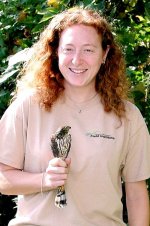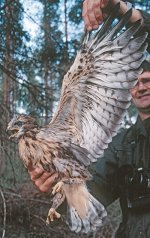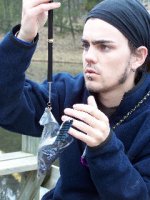FalconBirder
Raptor Ethologist
I'm deeply concerned about two aspects of what I believe is mis-handling of birds of prey by ringers and banders.
Both methods are frequently illustrated on the internet and in publications, including in books and on websites of some so-called raptor experts.
The two methods are:
a) Holding a small raptor tightly in one hand with its legs, wings and tail all scrunched up together - see image one. This habit seems to be particularly prevalent in America.
The remiges and retrices are absolutely critical to any raptor's survival and I believe this method creates a high risk of lasting mechanical damage to these feathers due to the application of forces for which they are not designed to withstand.
b) Holding open the wing of a raptor by means of the tips of the outer remiges for a photograph - see image two.
For obvious reasons raptors have powerful flight muscles and apart from the procedure damaging the feather tips, if the bird is suddenly startled and pulls in its wing there is a very real risk of damaging the base of the feather (particularly if it is still growing) leading to it being 'dropped' prematurely and perhaps even failing to produce a replacement.
There are far better alternatives to both these methods and I believe ringers and banders should do their utmost to outlaw these practices.
Apart from the real risk to the individual raptors, I believe it also sends a very worrying message to non-ringers/banders that the welfare of the birds is secondary when it comes to capturing images of them.
What do others think please?
Both methods are frequently illustrated on the internet and in publications, including in books and on websites of some so-called raptor experts.
The two methods are:
a) Holding a small raptor tightly in one hand with its legs, wings and tail all scrunched up together - see image one. This habit seems to be particularly prevalent in America.
The remiges and retrices are absolutely critical to any raptor's survival and I believe this method creates a high risk of lasting mechanical damage to these feathers due to the application of forces for which they are not designed to withstand.
b) Holding open the wing of a raptor by means of the tips of the outer remiges for a photograph - see image two.
For obvious reasons raptors have powerful flight muscles and apart from the procedure damaging the feather tips, if the bird is suddenly startled and pulls in its wing there is a very real risk of damaging the base of the feather (particularly if it is still growing) leading to it being 'dropped' prematurely and perhaps even failing to produce a replacement.
There are far better alternatives to both these methods and I believe ringers and banders should do their utmost to outlaw these practices.
Apart from the real risk to the individual raptors, I believe it also sends a very worrying message to non-ringers/banders that the welfare of the birds is secondary when it comes to capturing images of them.
What do others think please?






